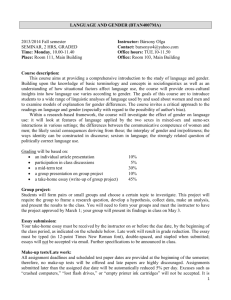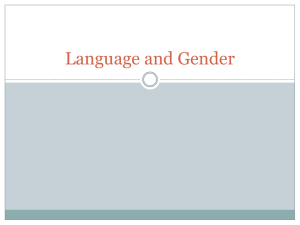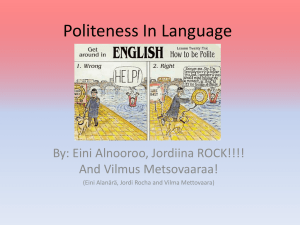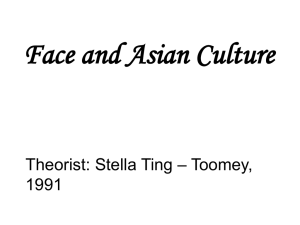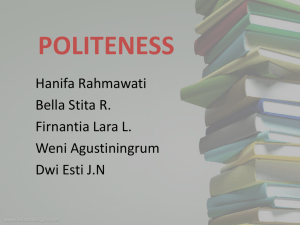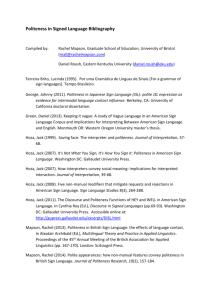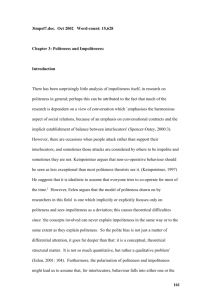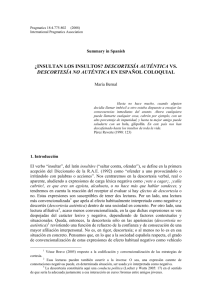Taking Things at Face Value: How Stance Informs
advertisement
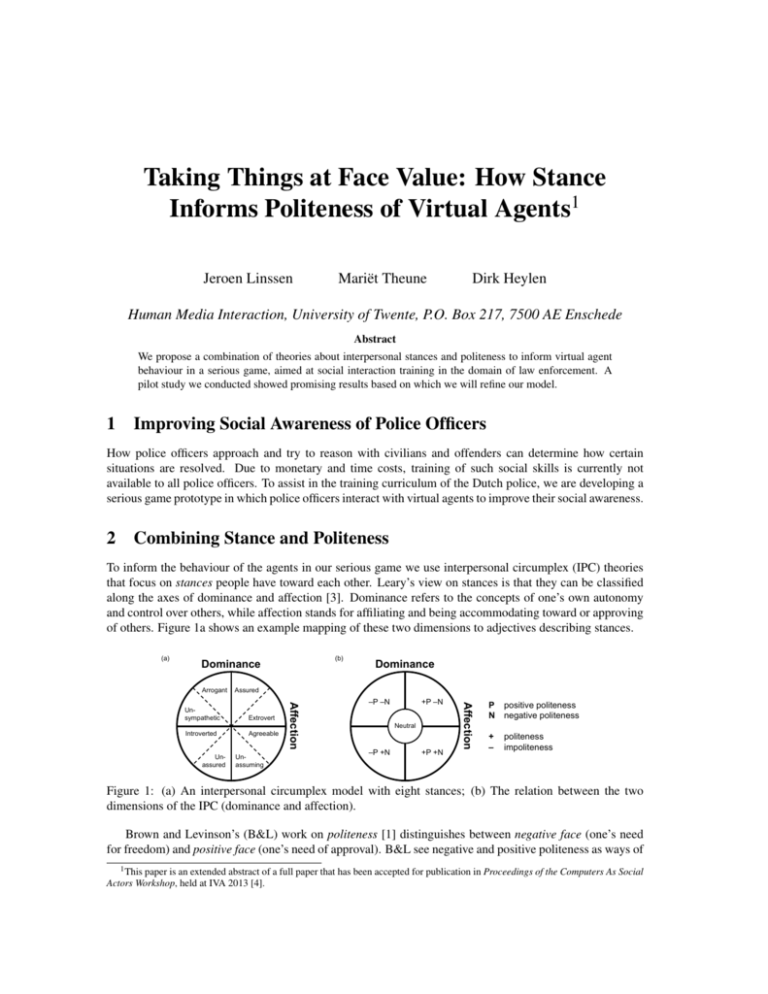
Taking Things at Face Value: How Stance Informs Politeness of Virtual Agents1 Jeroen Linssen Mariët Theune Dirk Heylen Human Media Interaction, University of Twente, P.O. Box 217, 7500 AE Enschede Abstract We propose a combination of theories about interpersonal stances and politeness to inform virtual agent behaviour in a serious game, aimed at social interaction training in the domain of law enforcement. A pilot study we conducted showed promising results based on which we will refine our model. 1 Improving Social Awareness of Police Officers How police officers approach and try to reason with civilians and offenders can determine how certain situations are resolved. Due to monetary and time costs, training of such social skills is currently not available to all police officers. To assist in the training curriculum of the Dutch police, we are developing a serious game prototype in which police officers interact with virtual agents to improve their social awareness. 2 Combining Stance and Politeness To inform the behaviour of the agents in our serious game we use interpersonal circumplex (IPC) theories that focus on stances people have toward each other. Leary’s view on stances is that they can be classified along the axes of dominance and affection [3]. Dominance refers to the concepts of one’s own autonomy and control over others, while affection stands for affiliating and being accommodating toward or approving of others. Figure 1a shows an example mapping of these two dimensions to adjectives describing stances. (a) (b) Dominance Arrogant Assured Introverted Agreeable Unassuming –P –N +P –N Neutral –P +N +P +N Affection Extrovert Affection Unsympathetic Unassured Dominance P N positive politeness negative politeness + – politeness impoliteness Figure 1: (a) An interpersonal circumplex model with eight stances; (b) The relation between the two dimensions of the IPC (dominance and affection). Brown and Levinson’s (B&L) work on politeness [1] distinguishes between negative face (one’s need for freedom) and positive face (one’s need of approval). B&L see negative and positive politeness as ways of 1 This paper is an extended abstract of a full paper that has been accepted for publication in Proceedings of the Computers As Social Actors Workshop, held at IVA 2013 [4]. ‘saving’ either the negative or positive face of a hearer. Complementing this notion of politeness, Culpeper, Bousfield and Wichmann see negative and positive impoliteness as a way to attack the other’s face [2]. We argue that stances are closely related to politeness. Dominance and affection, the two dimensions of the IPC, are very similar to the concepts of negative and positive face, respectively. We propose that the different politeness (and impoliteness) strategies addressing negative and positive face can be mapped straightforwardly to IPC stances (see Fig. 1b). Based on this mapping, we can construct utterances for a given stance by combining the politeness strategies that correspond to that stance. This approach enables us to ground characters’ realised behaviour in their attitudes towards each other which is important for the type of social interaction we try to achieve. 3 Pilot Study To validate our ideas about the mapping of a person’s stance to the politeness of that person’s utterances, we conducted a small user experiment. We constructed utterances of police officers during interaction with loitering juveniles based on five stances: four combinations of high and low dominance or affection and a fifth ‘neutral’ stance. For example, an arrogant or unsympathetic police officer would use a combination of negative and positive impoliteness such as “What a racket! You have to stop this immediately.” We carried out an online survey in which participants (non-police officers) rated these utterances in terms of dominance and affection. A total of 18 participants rated 40 different utterances. The results of our pilot study show, among other things, that utterances combining two (negative and positive) impoliteness strategies were indeed rated as more dominant and less affectionate than utterances that combined two politeness strategies. However, on the whole the utterances we constructed were neither rated as very dominant or not dominant nor as very affectionate or unaffectionate, possibly because they lacked intonation and body language. Nevertheless, the results do confirm our hypothesis that, at least for some stances, B&L’s politeness and Culpeper et al.’s impoliteness strategies can be used to construct utterances that adequately reflect a given stance. 4 Future Work Our pilot study shows that our approach of combining IPC and politeness theories to construct utterances can be a good starting point to inform virtual agent behaviour, yet needs more refinement before implementation in our serious game. We plan to conduct studies with both police officers and (ex) loitering juveniles to gather empirical data on the politeness strategies they use. After more refinement and evaluation with these domain experts, we will integrate our model in our serious game. Acknowledgements This publication was supported by the Dutch national program COMMIT. References [1] P. Brown and S.C. Levinson. Politeness: Some universals in language usage. Cambridge University Press, Cambridge, 1987. [2] J. Culpeper, D. Bousfield, and A. Wichmann. Impoliteness revisited: With special reference to dynamic and prosodic aspects. Journal of Pragmatics, 35(10):1545–1579, 2003. [3] T.F. Leary. Interpersonal diagnosis of personality. Ronald Press, New York, 1957. [4] J.M. Linssen, M. Theune, and D.K.J. Heylen. Taking things at face value: How stance informs politeness of virtual agents. In Proceedings of the Computers As Social Actors (CASA) Workshop at IVA 2013, Edinburgh, UK, 2013. Accepted for publication.


